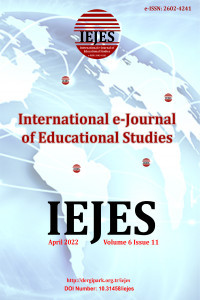Thinking Styles of New Mathematics Teachers and Their Relation to Self-Esteem
Mathematics, new teachers, self-esteem, thinking style
Thinking Styles of New Mathematics Teachers and Their Relation to Self-Esteem
Mathematics, New Teachers, Self-Esteem, Thinking Style,
___
- Algani, Y. (2018). Applying creative skills in teaching math at the primary school stage. Journal of International Economy and Business, 6, 26-33.
- Algani, Y., M., & Eshan, J. (2019a). Reasons and suggested solutions for low-level academic achievement in mathematics. International e-Journal of Educational Studies (IEJES), 6 (3), 142-151. DOI: 10.31458/iejes.571751.
- Algani, Y. (2019b). Innovative ways to teach mathematics: Are they employed in schools? Journal of Computer and Education Research (JCER), 7(14), 496-514. DOI: 10.18009/jcer.612199.
- Barry, C., Grafeman, S., Adler, K. & Pickard, J. (2007). The relations among narcissism, self-esteem and delinquency in a sample of at- risk adolescents. Journal of Adolescence, 30(6), 933- 942.
- Bolkamedy, A. (2012). Methods of thinking and their relationship to self-esteem in on secondary school students. The Journal of Humanities and Social Sciences, 12(1), 209-229.
- Brand, S., Felner, R., Seitsinger, A., Burns, A.& Bolton, N. (2008). A large scale study of the assessment of the social environment of middle and secondary schools: The validity and utility of teachers' ratings of school climate, cultural pluralism, and safety problems for understanding school effects and school improvement. Journal of School Psychology, 13(9), 239-253.
- Ciarrochi, J., Heaven, P., & Davies, F. (2007). The impact of hope, self-esteem, and attributional style on adolescents’ school grades and emotional well- being: A longitudinal study. Journal of Research in Personality , 41(16), 1161-1174.
- Grigorenko, E., & Sternberg, R. (1995). Thinking styles in school settings. European Journal of High Ability, 9(1), 201- 219.
- Khun, H. (2017). The effect of students’ confidence level toward mathematics performance among southern Thailand primary school children. International Journal of Academic Research in Progressive Education and Development, 6(2), 132-141.
- Keşan, C., & Kaya, D. (2018). Mathematics and science self-efficacy resources as the predictor of academic success. International Online Journal of Educational Sciences, 10(2), 45-58.
- Lawrence, D. (1996). Enhancing self-esteem in the classroom, (2nd Ed), London: poulchapman publishing.
- Sellah, L., Jacinta, K., & Helen, M. (2018). Predictive power of cognitive styles on academic performance of students in selected national secondary schools in Kenya. Cogent Psychology Journal, 6(2), 91-101.
- Martinez-Romera, D.D., Sternberg, W. (2018). Thinking styles: A research tool in social science didactics. Journal of Technology and Science Education, 8 (4), 398-407.
- Pryor, J. (1994). Self- esteem and attitudes toward gender roles: Contributing factors in adolescence. Australian Journal of Psychology, 46 (1), 48 – 52.
- Sternberg, R. (1988). Mental self-government: A theory of intellectual styles and their development. Human of Development, 16(3), 197- 224.
- Sternberg, R. (1997). Functions of thinking styles: The legislative, executive, and judicial styles. in thinking styles, Cambridge University Press, 27-43.
- Sternberg, R.J. & Grigorenko, E.L. (1997). Are cognitive styles still in style? American Psychologist, 52(7), 700- 712.
- Twashemly, R. (2008). Mathematics students' thinking styles and their relationship to some variables, The Journal of Humanities and Social Sciences, 11(3), 514-523.
- Weber, S., Puskar, K., & Ren, D. (2010). Relationships between depressive symptoms and perceived social support, self-esteem, & optimism in a sample of rural adolescents. Issues in Mental Health Nursing, 31, 584–588.
- Zhang, L. F. (2001). Thinking styles, self-esteem, and extracurricular experiences. International Journal of Psychology, 36 (2),100-107.
- Zhang, L. F. (2002a). The role of thinking styles in psychosocial development. Journal of College Student Development, 43(5), 696-711.
- Zhang, L. F. (2002b). Thinking styles: Their relationships with modes of thinking and academic performance. Educational Psychology, 22 (3), 331-348.
- Zhang, L. (2006). Thinking styles and the big five personality traits revisited. Personality and Individual Differences, 40(6), 1177- 1187.
- Başlangıç: 2017
- Yayıncı: Tamer KUTLUCA
Thinking Styles of New Mathematics Teachers and Their Relation to Self-Esteem
The Role of Stakeholders in The Makassar Tidak Rantasa’ Program: Knowledge and Public Participation
Andi Fajar ASTİ, Yufiarti YUFIARTI, Henita RAHMAYANTI
Andi SAPARİA, Firmansyah DLIS, Achmad Sofyan HANIF
Curriculum and Learning Policy In Sustainable Completed Class System In Gowa Regency, South Sulawesi
Burhan BURHAN, Suparno EKO WIDODO, Sutjipto SUTJIPTO
Abdullatif SETİABUDİ, Muchlis. R. LUDDIN, Yuli RAHMAWATI
Mindfulness: Views of Turkish Pre- Service Early Childhood Teachers
Funda Eda TONGA, Feyza TANTEKİN ERDEN
Agung Surya DWİANTO, R. Madhakomala R. MADHAKOMALA, Hamidah HAMİDAH
